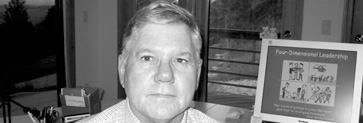
By Jeffrey Bauer
Back in 2000, one of the potential Mars projects involved delivering and then flying an observation plane over the planet. Among the challenges of the project was the small size of the capsule that was going to be used in order to get the plane to Mars. With the planet’s thin atmosphere, a plane would need to have large wings in order to fly efficiently. How could you package a large-winged plane in a small capsule?
Wings that inflate when needed seemed like an ideal solution to the problem. I knew that people had been working on the concept of inflatable wings for other applications, but the technology was immature and unproven. Before anyone would consider a design incorporating inflatable wings, you had to know the concept was sound. And that’s where prototyping enters this story.
I got together a small team. We learned that a set of small-scale inflatable wings had been created for a Navy munitions application through a Small Business Innovative Research (SBIR) program. At the conclusion of that SBIR, the prototype wings became the property of the government, and the Navy program offered to transfer the hardware over to us. With the wings in hand, we secured discretionary funding to test our design concept.
In a sense, this prototype we were going to build was the product. We were just trying to answer some fundamental questions before we went out and tried to advocate for significant funding to do anything real. And therein lay the beauty of prototyping: it allows you to try a lot of things in a short period of time, without having to spend a lot of money to try them. There were lots of doubters about whether or not this idea had practical merit, and we didn’t know for sure ourselves whether any of our ideas would pan out.
We had our model shop design a small airplane around the set of wings. All the testing that had been done under the SBIR had used pre-inflated wings; because we needed wings that could be inflated in flight, we also needed to design an in-flight inflation system. We came up with a system that used compressed nitrogen gas to inflate the wings.
Our prototype flew with stable enough dynamics that it could be controlled and land successfully. We had proven the principle that, yes, you could inflate wings in flight that wouldn’t fold back on themselves or fail in any other mechanics. We had proven the concept to be a viable option for vehicles with volume constraints.
We shot a video as we ran several drop tests where we inflated the wings in flight under varying conditions, and then put together a demo to prove to others that this concept does seem to have some merit.
At the time we did this demonstration, the interest for a Mars aircraft program faded, and it wasn’t among the missions selected to fly. To our great satisfaction, however, that wasn’t the final word on our prototype project.
We sent the test flight video off to anyone we thought might be interested in the concept. One of those people was an associate in the military. At the time, he was trying to sell a program that relied on the use of inflatable wings. Whenever he briefed people about the program, they all told him that it was unproven and too risky a concept to consider.
View graphs and a lot of conjecture don’t inspire people to invest in projects. Proof of concept does. Once he had our video as proof of concept, he successfully sold a $50-million program based on our low-cost (roughly $100,000) prototype.
Why use a prototype? If you can validate basic principles early in the life of a project, you mitigate risks substantially before you embark on a full-scale development effort. We answered a fundamental question before we went out and tried to advocate for significant project funding. Things might not have turned out exactly as we had wished, but another part of the government was able to benefit from our work, and we are proud of that.
Lessons
- Prototyping is one of the most crucial tools for innovation. Ideas can be tested and verified quickly by prototyping, before an extensive commitment of resources.
- One prototype is worth a thousand words. A good prototype has the power to communicate more convincingly than any analysis.
Question
How do you develop a knowledge database for prototypes?








